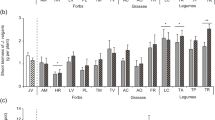Abstract
The interference between maize andEchinochloa colona was studied by growing the two species in pure and mixed stands under varied nutritional levels in the soil. Both the species responded to density stress in pure stands by mortality and plasticity. Density dependent mortality was comparatively higher for maize than forE. colona. The higher mortality rate of maize was related to the higher growth rate in this species. The dry matter production was also more sensitive to density stress for maize than forE. colona. The generally higher mortality in the more fertile soil was explained as due to the better expression of genotypic individual differences and the consequent elimination of the weaker individuals by more vigorous ones.
In mixed stands, whilst the reciprocal effects of the weed and the crop were brought out due to suitable experimental design, the effect of the weed on the crop was less marked as compared to the reverse effect. This was due to differences in size and growth habit of the two competing species. Whilst the effect of the weed on the crop may be purely a competition by roots for nutrients from the soil the reverse effect could be primarily due to shading of the weed by the crop. The plasticity and mortality responses of the two competing species are discussed and it was shown that: (i) the effect of the weed on the crop was enhanced due to an early start that the former may receive in the mixture and the adverse effect was realized in cob characters and (ii) the interference from the weed to the crop is a continued risk throughout the life cycle and that longer the period of association between the two, greater the damage done to crop yield.
Similar content being viewed by others
References
Harper, J. L. and Gagic, D., Experimental studies on the mortality and plasticity of a weed.Weed Res. 1 91–104 (1961).
Ramakrishnan, P. S. and Kumar, S., Mortality, plasticity and productivity of interfering model populations of maize andCynodon dactylon (L.).Pers. J. Indian Bot. Soc. 50 321–331 (1971a).
Ramakrishnan, P. S. and Kumar, S., Productivity and plasticity of wheat andCynodon dactylon (L.) Pers. in pure and mixed stands.J. Appl. Ecol. 8 85–98 (1971b).
Donald, C. M., Competition among pasture plants.Adv. Agron. 15 1–118 (1963).
Kapoor, P. and Ramakrishnan, P. S., Studies on crop-legume behaviour in pure and mixed stands,Agro-Ecosystems 2 61–74, 1975.
Ramakrishnan, P. S., Ecology ofEchinochloa colonum Link.,Proc. Indian Acad. Sci. 53 B 73–90 (1960).
Kapoor, P. and Ramakrishnan, P. S., Soil factors influencing the distribution of ecotype populations inEchinochloa colonum (L.) Link. (Gramineae).Bot. J. Linn. Soc. 69 65–78 (1974).
Piper, C. S.,Soil and Plant Analysis. Interscience, New York (1944).
Snell, F. D. and Shell, C. T.,Colorimetric Methods of Analysis. Vol. II, D. Van Nostrand Co., Inc., New York (1949).
Harper, J. L., A Darwinian approach to plant ecology.J. Ecol. 55 247–270 (1967).
Ramakrishnan, P. S., A comparative study of productivity in monocultures of species of varied ecological characteristics. InTropical Ecology Emphasizing Organic Production. (ed. P. M. Golley and F. B. Golley), Athens, Georgia, 121–135 (1972).
Ramakrishnan, P. S., Individual behaviour of some legumes in monocultures related to growth rate.Proc. Indian Acad. Sci. 48 212–221 (1973).
Sukatchev, Y. N.,Plant Communities (in Russian) Moscow (1928).
Yoda, K., Kira, T., Hozumi, H. and Kira, H., Self-thinning in overcrowded pure stands under cultivated and natural conditions.J. Biol. Osaka City Univ.14 107–129 (1963).
White, J. and Harper, J. L. Correlated changes in plant size and number in plant populations.J. Ecol. 58 467–485 (1970).
Kira, T., Ogawa, H. and Sagazaki, N., Intraspecific competition among higher plants. I. Competition-density-yield relationship in regularly dispersed populations.J. Inst. Polytech., Osaka City (1953).
Harper, J. L., The nature and consequence of interference amongst plants.Proc. XIth Int. Conf. Genet. pp 465–481 (1964).
Eddowes, M., Physiological studies on competition inZea mays L. II. Effect of competition among maize plants,J. Agric. Sci. 72 195–202 (1969).
Bradshaw, A. D., Evolutionary significance of phenotypic plasticity in plants.Adv. Genet. 13 115–155 (1965).
Harper, J. L. and McNaughton, I. H., The comparative biology of closely related species living in the same area. VII. Interference between individuals in pure and mixed populations ofPapaver species,New Phytol. 61 175–188 (1962).
Ramakrishnan, P. S., Nutritional requirements of the edaphic ecotypes inMelilotus alba Medic. III. Interference between the calcareous and acidic populations in the two soil types,New Phytol. 69 81–86 (1970).
Van den Bergh, J. P. and Elberre, W., The yield of monocultures and mixtures of two grass species differing in growth habit,J. Appl. Ecol. 7 311–320 (1970).
Author information
Authors and Affiliations
Rights and permissions
About this article
Cite this article
Kapoor, P., Ramakrishnan, P.S. Weed-crop behaviour in pure and mixed stands of maize andEchinochloa colona Link. Proc. Indian Acad. Sci. 82, 175–194 (1975). https://doi.org/10.1007/BF03050531
Received:
Revised:
Issue Date:
DOI: https://doi.org/10.1007/BF03050531




